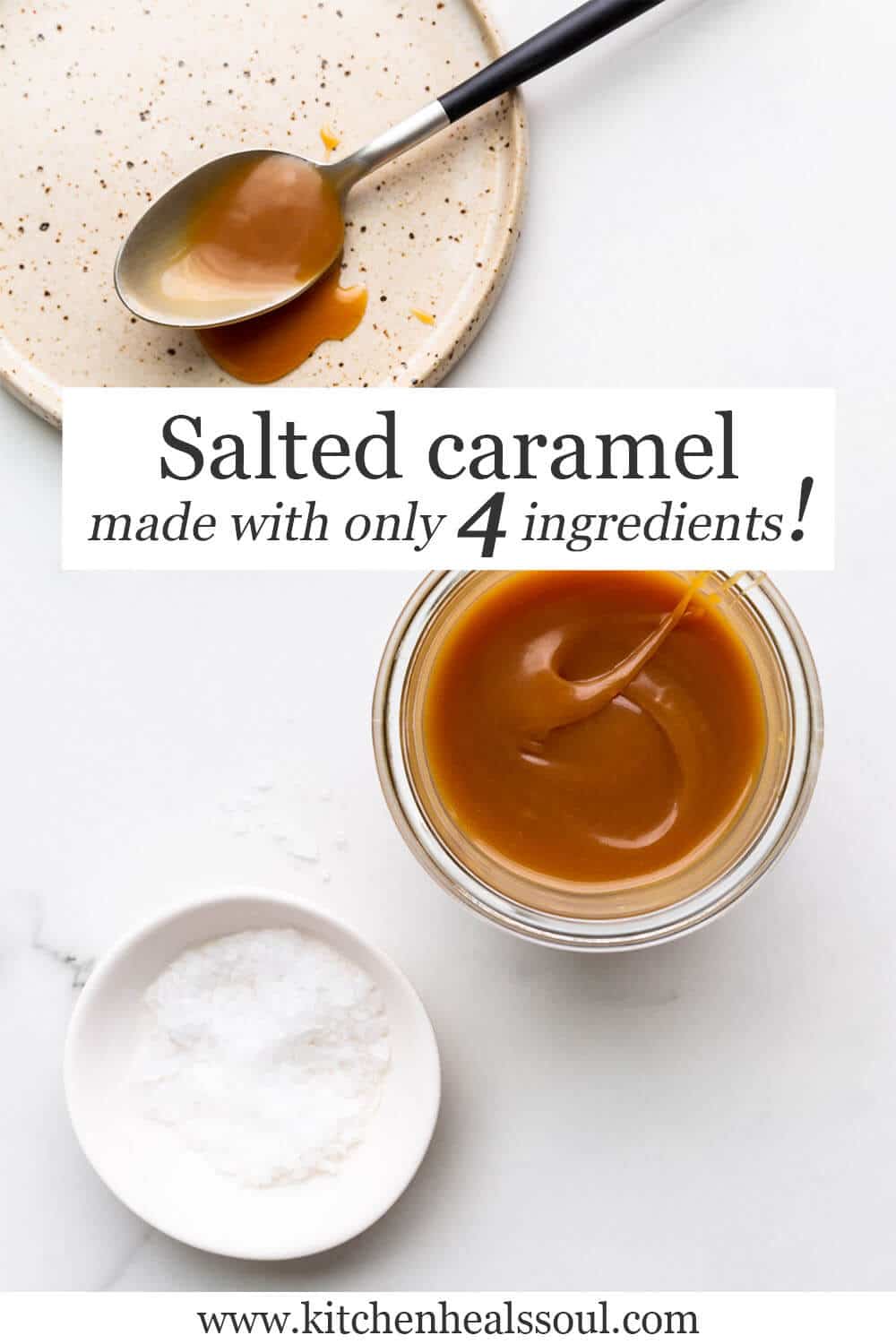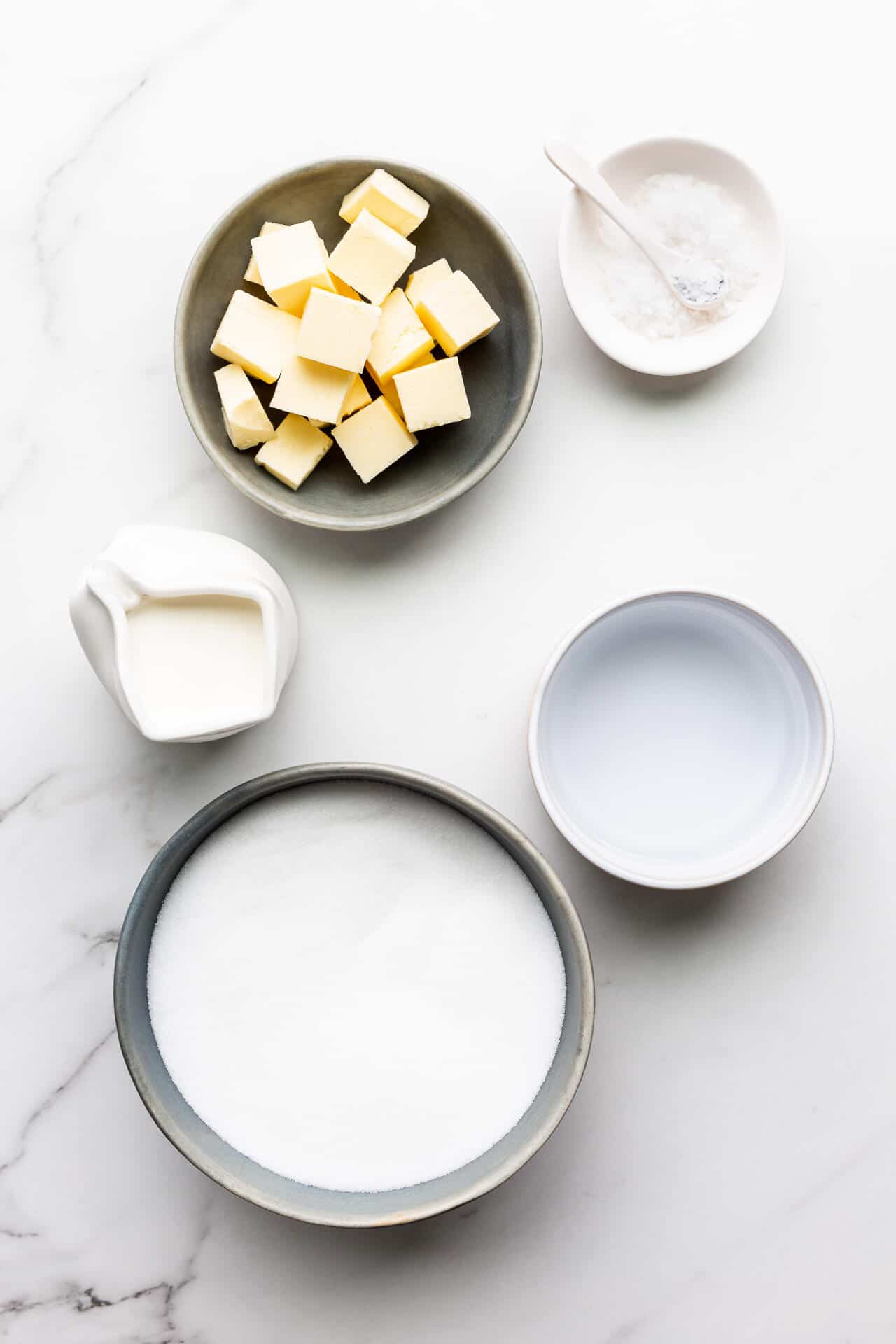Learn how to make salted caramel sauce from a very simple list of ingredients. It takes less than 20 minutes and it's definitely worth every second.

Salted caramel sauce is made from just 3 ingredients (4 if you count water)
All you need to make caramel sauce is a lot of sugar, whipping cream, butter, and a little water, which helps dissolve the sugar to form a syrup that is easier to work with, especially for beginner bakers. Other optional ingredients include vanilla extract (to give the caramel sauce more flavour), and salt (often sea salt), but you may skip the salt if you make your caramel sauce with salted butter.
Some recipes may include a splash of lemon juice or vinegar, or they may include a little glucose, corn syrup, or honey. These ingredients are optional and they are added to reduce the risk of the caramel sauce crystallizing at any point in the process. Florentine cookies are made with a little honey, not only adding flavour, but also preventing crystalllization.
Unsalted butter versus salted for making caramel sauce
The French baking term for salted caramel sauce is "caramel au beurre salé" because this is a recipe that can be made with salted butter. If you use salted butter, feel free to taste and adjust with a little extra salt (making sure to let the sample cool down BEFORE you try to eat it!). I find with most brands of salted butter, they provide plenty of salt.
If you make this recipe with unsalted butter, you will have to add salt. Use up to 5 mL (1 teaspoon) of flaky sea salt or fine kosher salt (such as Diamond crystal). If you are using table salt, add less salt! Use half that amount, so 2.5 mL (½ teaspoon) of salt because table salt is saltier than sea salt and the baking substitution table salt and sea salt isn't 1-to-1.

The impact of temperature on flavour
The sugar in caramel sauce contributes the caramel flavour but that sugar has to be heated, otherwise it doesn't contribute much of any flavour and actually will make a sauce cloyingly sweet. The sugar breaks down when it's heated above a certain temperature, causing it to change colour (to amber-brown) and change flavour. Caramelization occurs above 330 ºF (165 ºC), at which point there is very little water left in the hot sugar syrup. Below this temperature, the mixture contains enough water that the sugar doesn't break down, but above that temperature, it does, leading to a colour change and also the development of flavour compounds.
Making caramel starts with dissolving the sugar in water, with the help of a gentle heat. The goal is to dissolve all the crystals to avoid any crystallization down the road. Once the sugar is dissolved, the syrup is heated past 330 ºF (165 ºF), at which point the water has mostly evaporated and the sugar begins to caramelize, changing colour and developing flavour.
The high temperature of hot caramel means that when you add the cream and the butter, the milk solids brown almost immediately, leading to even more flavour in the sauce.

Using a thermometer for caramel sauce
While I always recommend using a thermometer when you are making recipes that are sensitive to temperature, like those made by heating sugar, in this case, you don't need a thermometer. When you are making preserves, I always suggest using a digital instant-read thermometer to make sure you've hit the jam setting point. The same goes for if you are heating a sugar syrup to the soft ball temperature to make an Italian meringue buttercream or a batch of vanilla marshmallows.
For caramel sauce, I've found over the years that some thermometers aren't very accurate at higher temperatures and using a thermometer can be misleading and lead you to turning off the heat before the sugar has caramelized enough, leading to a blonder caramel that is more cloyingly sweet and less flavourful. For this reason, I encourage you to watch the sugar syrup as it boils. You will see it turn a pale yellow colour at the beginning of the process, and that colour will develop and deepen into a rich, dark amber, at which point you can safely turn off the heat and add the butter and the cream. You will obtain a rich tasting dark caramel sauce that is full of flavour.
While I suggest you don't use a thermometer to make caramel sauce, I do suggest you use one to make soft, chewy caramels. You can make caramels by heating caramel sauce (made from caramelized sugar, cream, and butter) to 250 ºF or 121 ºC, which is the firm ball stage of sugar syrups (which is in the middle of the hard ball temperature range which spans from 240 ºF and 265 ºF or from 116 ºC to 129 ºC). So if you cook the recipe below for caramel sauce to 250 ºF (121 ºC), and pour it in a buttered pan. Let the boiled caramel set in the pan and then cut into squares so you can share your chewy sea salt caramels.

Salted caramel sauce is a little different than dulce de leche, which is another flavourful sauce made from sweetened condensed milk that is heated until the sugar and milk solids caramelize. Both dulce de leche and caramel sauce make great glazes for bundt cakes, like to glaze this apple bundt cake, as well as fillings for layer cakes, like in this chocolate caramel cake. You can also swirl it into a batch of homemade vanilla bean ice cream or serve it with crêpes.
📖 Recipe

Salted Caramel Sauce
Equipment
Ingredients
- 125 mL water plus more for brushing sides of pan
- 400 grams granulated sugar
- 115 grams salted butter cut into cubes
- 250 mL whipping cream (35 % fat)
Instructions
- Measure all your ingredients before beginning and have them ready. This is very important.
- In a deep 3 quart saucepan, pour the water, and then the sugar. Don’t stir it.
- Bring the mixture to a boil over medium heat. If there’s sugar stuck on the sides of the pan, carefully brush it with a heat-resistant silicone brush dipped in a little water. Feel free to swirl the pan to give the mixture a stir, but when you set it back on the burner, brush the edges of the pan with water to dissolve the sugar crystals from the walls of the pot.
- Once the sugar is completely dissolved and the mixture starts to bubble, you can increase the heat on the stove to medium–high, or you can leave it on medium. The only difference is that on medium, it will take longer for the mixture to caramelize.
- Continue to boil the caramel until it turns amber in colour. As soon as the caramel has reached the desired colour, slide the pan off the heat, and turn the burner off.
- Slowly and carefully drop in the cubed butter (it will bubble and erupt so be careful!). Pour in the cream, slowly and carefully.
- When the bubbling has calmed down, begin to gently whisk the caramel until it is smooth and homogeneous.
- Poor the salted caramel in a large jar and cover loosely. When the caramel has cooled to room temperature, you can tighten the lid and store it in the refrigerator. It will thicken as it cools.
Notes
- I highly recommend watching the colour change closely to determine if your caramel has cooked enough, but if you want to check the temperature, aim for somewhere between 350°F and 360°F with a candy thermometer before adding the butter and cream.






Vineeta Gogia says
Lovely recipe and great explanation.I have a bakery and will scale up the to at least to 3 kgs sugar . I want to know to prevent recrystallisation of sugars after the caramel is made and even during the process would you recommend that I add both cream of tartare AND LIQUID GLUCOSE or just one would do ? Thank you for your help.
Janice says
Hi, Either will work. I don't think you need both. I'd probably use glucose, personally. Hope that helps!
Beth says
Janice
I tried to make this yesterday - I have used other recipes before but was intrigued - I am not understanding the water. What I ended up with was caramel soup - no thickening as it cooled. I tried it again, thinking maybe I hadn't cooked it long enough - cooked longer, still same result. I made no substitutions with ingredients. I have never seen another recipe for caramel with water. I was wanting caramel sauce that is fairly thick. What do you think went wrong? (I am an experienced baker) Thanks
Janice says
Hi Beth, I'm sorry you ended up with caramel soup. When making caramel, there are two paths to take, a dry caramel or a wet caramel. Both classic pastry methods work but each one has its faults. A dry caramel made with straight sugar heated in a saucepan can burn before you've done melting all the sugar, which can lead to off flavours in the sauce. I use a dry caramel to make this apple tarte tatin for example. On the other hand, a wet caramel (like the one here) can lead to the sugar crystallizing as you boil it down if the sugar hasn't fully dissolved. But with practice, both lead to the same outcome. The water in caramel recipes shouldn't have an impact on the texture in the end. It's added at the beginning to help dissolve all the sugar crystals before boiling so that caramelization is more even in the end. The boiling point of water is 100 °C or 212 °F and caramelization begins around 160 °C or 320 °F. This means that when the sugar begins to take on some caramel colour, the water has all evaporated and that the syrup that is left in your pot is 100 % sugar. There is virtually no water left in a wet caramel when the sugar is caramelizing.
If you ended up with caramel soup, this likely means that the ratio of sugar to cream was probably off and that you had more cream than necessary. Another thought is that perhaps the caramel hadn't cooled sufficiently. The sauce is more fluid the hotter it is, and quite thick if it's fridge cold. Did letting it chill in the fridge overnight help?
While, I don't have an exact answer to what happened to you yesterday, I hope this answer will help you when you try again!